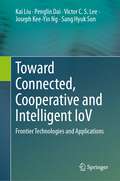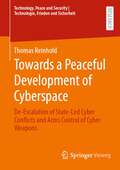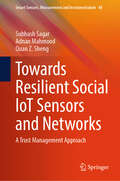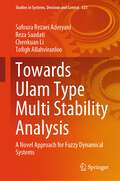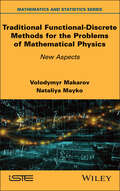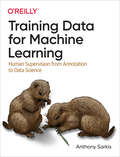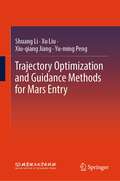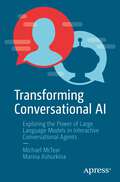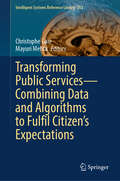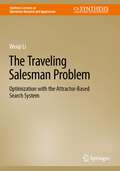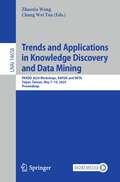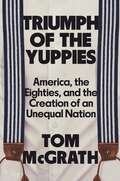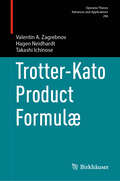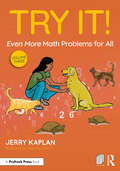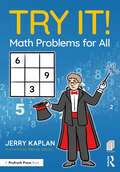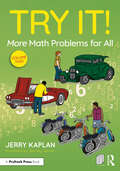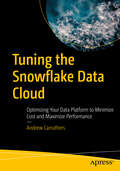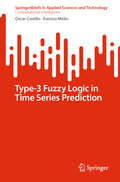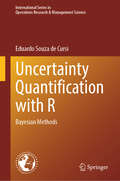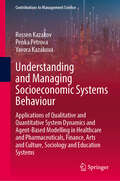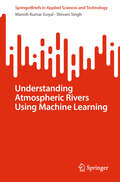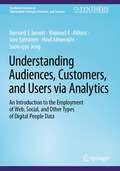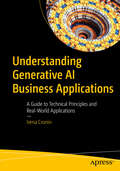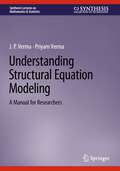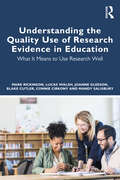- Table View
- List View
Toward Connected, Cooperative and Intelligent IoV: Frontier Technologies and Applications
by Kai Liu Penglin Dai Victor C.S. Lee Joseph Kee-Yin Ng Sang Hyuk SonThis book offers a comprehensive introduction to technological advances in Internet of Vehicles (IoV), including vehicular communications, vehicular system architectures, data dissemination algorithms, resource allocation schemes, and AI-enabled applications. It focuses on the state-of-the-art IoV with regard to three major directions, namely networking, cooperation, and intelligence, including advanced wireless communication technologies, algorithm theory, optimization mechanisms, and AI technologies. In addition, the book includes a number of case studies with system prototype implementation and hands-on experiments in IoV, making it suitable both as a technical reference work for professionals and as a textbook for graduate students.
Towards a Peaceful Development of Cyberspace: De-Escalation of State-Led Cyber Conflicts and Arms Control of Cyber Weapons (Technology, Peace and Security I Technologie, Frieden und Sicherheit)
by Thomas ReinholdThe cyberspace and its global infrastructures are essential for our civilizations, the economy and administration. However, cyberspace is also increasingly developing into an intelligence and military operational area, visible in the creation of military cyber departments and the integration of cyberspace into states' security and defense strategies. Unfortunately, many of the established toolset of transparency, de-escalation and arms control measures do not work for cyberspace due to its specific technical characteristics. But how de-escalation of state-led conflicts in cyberspace can be achieved and how arms control of cyber weapons can be developed? Based on a technical perspective with regard to the underlying political challenges, the book follows an approach of adopting already existing technical measures from other fields of the computer science. It presents a classification system for cyberweapons, an approach for the mutual reduction of vulnerability stockpiles and provides an approach to prove the non-involvement in a cyber conflict. Beyond this, it aims to provide some impulses regarding the responsibility and creative options of the computer science with a view to the peaceful development and use of cyberspace.
Towards Resilient Social IoT Sensors and Networks: A Trust Management Approach (Smart Sensors, Measurement and Instrumentation #48)
by Quan Z. Sheng Adnan Mahmood Subhash SagarThis book, at first, explores the evolution of the IoT to SIoT and offers a comprehensive understanding of SIoT and trust management vis-à-vis SIoT. It subsequently envisages trust quantification models by employing key SIoT-specific trust features, including SIoT relationships (e.g., friendships, working relationships, and community-of-interest), direct observations, and indirect observations, to augment the idea of trust quantification of a SIoT object. Furthermore, diverse trust aggregation techniques, i.e., conventional weighted sum, machine learning, and artificial neural networks, are proposed so as to address the challenges of the trust aggregation. Finally, the book outlines the future research directions for emphasizing the importance of trustworthiness management in the evolving notion of the SIoT.
Towards Ulam Type Multi Stability Analysis: A Novel Approach for Fuzzy Dynamical Systems (Studies in Systems, Decision and Control #523)
by Reza Saadati Tofigh Allahviranloo Safoura Rezaei Aderyani Chenkuan LiThe main target of this book is to present a new concept of Ulam-type stability, i.e., multi-stability, through the classical, well-known special functions and to obtain the best approximation error estimates by a different concept of perturbation stability including fuzzy approaches for uncertainty considerations. This stability allows us to obtain diverse approximations depending on various special functions that are initially chosen and to evaluate maximal stability and minimal error which enable us to obtain a unique optimal solution of functional equations, inequalities, and fractional equations. Stability analysis in the sense of the Ulam and its different kinds has received considerable attention from the researchers. However, how to effectively generalize the Ulam stability problems and to evaluate optimized controllability and stability are new issues. The multi-stability not only covers the previous concepts but also considers the optimization of the problem and provides a comprehensive discussion of optimizing the different types of the Ulam stabilities of mathematical models used in the natural sciences and engineering disciplines with fuzzy attitudes. Besides, this book also deals with nonlinear differential equations with various boundary conditions or initial value problems, based on the matrix Mittag-Leffler function, fixed point theory, as well as Babenko's approach to study uniqueness and existence of solutions. In general, the benefits for the readers can be concluded as follows: 1. Evaluates maximal stability with minimal error to get a unique optimal solution. 2. Discusses an optimal method of the alternative to study existence, uniqueness, and different types of Ulam stabilities under special consideration of the fuzzy approaches. 3. Delves into the new study of boundary value problems of fractional integro-differential equations with integral boundary conditions and variable coefficients.
Traditional Functional-Discrete Methods for the Problems of Mathematical Physics: New Aspects
by Volodymyr Makarov Nataliya MaykoThis book is devoted to the construction and study of approximate methods for solving mathematical physics problems in canonical domains. It focuses on obtaining weighted a priori estimates of the accuracy of these methods while also considering the influence of boundary and initial conditions. This influence is quantified by means of suitable weight functions that characterize the distance of an inner point to the boundary of the domain. New results are presented on boundary and initial effects for the finite difference method for elliptic and parabolic equations, mesh schemes for equations with fractional derivatives, and the Cayley transform method for abstract differential equations in Hilbert and Banach spaces. Due to their universality and convenient implementation, the algorithms discussed throughout can be used to solve a wide range of actual problems in science and technology. The book is intended for scientists, university teachers, and graduate and postgraduate students who specialize in the field of numerical analysis.
Training Data for Machine Learning
by Anthony SarkisYour training data has as much to do with the success of your data project as the algorithms themselves because most failures in AI systems relate to training data. But while training data is the foundation for successful AI and machine learning, there are few comprehensive resources to help you ace the process. In this hands-on guide, author Anthony Sarkis--lead engineer for the Diffgram AI training data software--shows technical professionals, managers, and subject matter experts how to work with and scale training data, while illuminating the human side of supervising machines. Engineering leaders, data engineers, and data science professionals alike will gain a solid understanding of the concepts, tools, and processes they need to succeed with training data.With this book, you'll learn how to:Work effectively with training data including schemas, raw data, and annotationsTransform your work, team, or organization to be more AI/ML data-centricClearly explain training data concepts to other staff, team members, and stakeholdersDesign, deploy, and ship training data for production-grade AI applicationsRecognize and correct new training-data-based failure modes such as data biasConfidently use automation to more effectively create training dataSuccessfully maintain, operate, and improve training data systems of record
Trajectory Optimization and Guidance Methods for Mars Entry
by Shuang Li Xu Liu Xiu-qiang Jiang Yu-ming PengThis book systematically investigates the Mars entry problem from the perspectives of deterministic optimization, uncertainty optimization, and guidance. Began with a detailed review of the robotic missions and human-scaled exploration plans to Mars, theories or concepts of optimal control, uncertainty quantification, robust optimization, model predictive control, sequential convex programming, and computational guidance are subsequently introduced. Correspondingly, this book presents a series of trajectory planning and guidance algorithms to improve the robustness, reliability, and safety of the Mars missions. Because the Mars entry problem is studied using advanced mathematics, including probability theory, optimization theory, and cybernetics, thus the book is primarily designed as a textbook for graduate students in aerospace engineering, aeronautics, and astronautics departments. Engineers and researchers may also use this book as a reference or tutorial to help with the modeling and simulation of the Mars entry problem due to its thorough simulations and analyses.
Transforming Conversational AI: Exploring the Power of Large Language Models in Interactive Conversational Agents
by Michael McTear Marina AshurkinaAcquire the knowledge needed to work effectively in conversational artificial intelligence (AI) and understand the opportunities and threats it can potentially bring. This book will help you navigate from the traditional world of dialogue systems that revolve around hard coded scripts, to the world of large language models, prompt engineering, conversational AI platforms, multi-modality, and ultimately autonomous agents.In this new world, decisions are made by a system that may forever remain a ‘black box’ for most of us. This book aims to eliminate unnecessary noise and describe the fundamental components of conversational AI. Past experiences will prove invaluable in constructing seamless hybrid systems. This book will provide the most recommended solutions, recognizing that it is not always necessary to blindly pursue new tools.Written in unprecedented and turbulent times for conversational interfaces you’ll see that despite previous waves of advancement in conversational technology, now conversational interfaces are gaining unparalleled popularity. Specifically, the release of ChatGPT in November 2022 by Open AI revolutionized the conversational paradigm and showed how easy and intuitive communication with a computer can be. Old professions are being disrupted, new professions are emerging, and even the most conservative corporations are changing their strategy and experimenting with large language models, allocating an unprecedented amount of budget to these projects. No one knows for sure the exact future of conversational AI, but everyone agrees that it’s here to stay. What You'll Learn See how large language models are constructed and used in conversational systems Review the risks and challenges of new technologies in conversational AI Examine techniques for prompt engineering Enable practitioners to keep abreast of recent developments in conversational AI Who This Book Is For Conversation designers, product owners, and product or project managers in conversational AI who wish to learn about new methods and challenges posed by the recent emergence in the public domain of ChatGPT. Data scientists, final year undergraduates and graduates of computer science
Transforming Public Services—Combining Data and Algorithms to Fulfil Citizen’s Expectations (Intelligent Systems Reference Library #252)
by Christophe Gaie Mayuri MehtaThis book provides a precise portrayal of the current trends and future perspectives of e-Government. It outlines new approaches that optimize public services across diverse sectors. Going beyond traditional boundaries, it offers mathematical models for public services supported by convincing case studies. This book significantly enhances various government services, such as education, healthcare, safety, security, and culture. It also strongly emphasizes safeguarding citizens' personal data, ensuring privacy, and obtaining explicit consent. Tailored for students and academics, the book is an invaluable reference for teaching graduate courses in e-Government, Process Modelling, or Artificial Intelligence. Its impact extends beyond the classroom; civil servants from all domains can find practical insights to navigate the ongoing modernization of public services. Even citizens curious about the transformation in their public services can find this book enlightening. Researchers working in the area of e-Governance can use this book to discover the recent developments in e-Government.
The Traveling Salesman Problem: Optimization with the Attractor-Based Search System (Synthesis Lectures on Operations Research and Applications)
by Weiqi LiThis book presents a new search paradigm for solving the Traveling Salesman Problem (TSP). The intrinsic difficulty of the TSP is associated with the combinatorial explosion of potential solutions in the solution space. The author introduces the idea of using the attractor concept in dynamical systems theory to reduce the search space for exhaustive search for the TSP. Numerous examples are used to describe how to use this new search algorithm to solve the TSP and its variants including: multi-objective TSP, dynamic TSP, and probabilistic TSP. This book is intended for readers in the field of optimization research and application.
Trends and Applications in Knowledge Discovery and Data Mining: PAKDD 2024 Workshops, RAFDA and IWTA, Taipei, Taiwan, May 7–10, 2024, Proceedings (Lecture Notes in Computer Science #14658)
by Zhaoxia Wang Chang Wei TanThis book constitutes the workshops that have been held in conjunction with the 27th Pacific-Asia Conference on Knowledge Discovery and Data Mining, PAKDD 2023, which took place in Osaka, Japan, during May 25–28, 2023. For RAFDA 2024, Workshop on Research and Applications of Foundation Models for Data Mining and Affective Computing, 15 submissions have been received and 9 full papers have been accepted for publication. For IWTA 2024, International Workshop on Temporal Analytics, 4 full papers have been accepted from a total of 6 submissions.
Triumph of the Yuppies: America, the Eighties, and the Creation of an Unequal Nation
by Tom McGrathThe &“entertaining and insightful&” first history of the Yuppie phenomenon, chronicling the roots, rise, triumph and (seeming) fall of the young urban professionals who radically altered American life between 1980 and 1987 (New York Times bestselling author Ben Mezrich). By the time their obituary was being written in the late 1980s, Yuppies—the elite, uber‑educated faction of the Baby Boom generation—had become a cultural punchline. But amidst the Yuppies' preoccupation with money, work, and the latest status symbols, something serious was happening, too, something that continues to have profound ramifications on American culture four decades later. Brimming with lively and nostalgic details (think Jane Fonda, The Sharper Image, and over-the-top fashion), Triumph of the Yuppies charts Boomers' transformation from hippy idealists in the late 1960s to careerists in the early 1980s, and details how marketers, the media, and politicians pivoted to appeal to this influential new group. Yuppie values had an undeniable impact on the worlds of fashion, food, and fitness, as well as affecting the broader culture—from gentrification and an obsession with career success to an indulgent materialism. Most significantly, the me‑first mindset typical of Yuppieness helped create the largest income inequality in a century. Tom McGrath&’s masterful cultural history reveals how Yuppies reshaped American society. It is a portrait of America just as it was beginning to come apart—and the origin story of the fractured country we live in today.
Trotter-Kato Product Formulæ (Operator Theory: Advances and Applications #296)
by Valentin A. Zagrebnov Hagen Neidhardt Takashi IchinoseThe book captures a fascinating snapshot of the current state of results about the operator-norm convergent Trotter-Kato Product Formulæ on Hilbert and Banach spaces. It also includes results on the operator-norm convergent product formulæ for solution operators of the non-autonomous Cauchy problems as well as similar results on the unitary and Zeno product formulæ.After the Sophus Lie product formula for matrices was established in 1875, it was generalised to Hilbert and Banach spaces for convergence in the strong operator topology by H. Trotter (1959) and then in an extended form by T. Kato (1978). In 1993 Dzh. L. Rogava discovered that convergence of the Trotter product formula takes place in the operator-norm topology. The latter is the main subject of this book, which is dedicated essentially to the operator-norm convergent Trotter-Kato Product Formulæ on Hilbert and Banach spaces, but also to related results on the time-dependent, unitary and Zeno product formulæ. The book yields a detailed up-to-date introduction into the subject that will appeal to any reader with a basic knowledge of functional analysis and operator theory. It also provides references to the rich literature and historical remarks.
Try It! Even More Math Problems for All
by Jerry KaplanThis is not your typical math book.Try It! Even More Math Problems for All is the third of three collections of offbeat, open-ended problems designed to make even the most math-averse student excited about working through these challenging yet accessible problems.The Hints and Solutions section guides you to probe, suggest, and encourage students to explore even their most unusual insights on the way to solving these 25 new, illustrated problems of varying difficulty. As a result, you will be able to motivate your students to think creatively on their own and to engage in teamwork. And when students solve a problem, you will see and hear their accomplishments.Perfect for any math classroom, club, after school activity, or coaching session, Try It! celebrates not only the destination, but the journey, giving students a chance to think differently, and, above all, have fun!Can’t get enough? Volume 1 in the series, Try It! Math Problems for All, and Volume 2, Try It! More Math Problems for All, are also available at Routledge.com.Optional Student Workbook PacksIn addition to this teachers' guide, companion student workbooks are available in packs of ten. The student workbooks feature ample room for student responses and notes, make reviewing and providing feedback on student work easy, provide students with a quick reference to use during discussions, and they save time — there is no need to reproduce student handouts.
Try It! Math Problems for All
by Jerry KaplanThis is not your typical math book. Breaking away from the standard drill and practice routine, Try It! Math Problems for All is a collection of offbeat, open-ended math problems designed to make even the most math-averse student excited about working through these challenging yet accessible problems. The 25 illustrated problems vary in difficulty, motivating students to think creatively on their own, or to engage in teamwork and cooperation within a group, while the Hints and Solutions section guides teachers to probe, suggest, and encourage students to explore even their most unusual insights on the way to a solution. Perfect for any math classroom, club, after-school activity, or coaching session, Try It! celebrates not only the destination, but the journey, giving students a chance to relax, think differently, and, above all, have fun! Optional Student Workbook Packs In addition to this teacher's guide, companion student workbooks are available in packs of ten. The student workbooks feature ample room for student responses and notes, make reviewing and providing feedback on student work easier than ever, provide students with an easy-to-use reference to use during discussions, and save time, as there is no need to reproduce student handouts.
Try It! More Math Problems for All
by Jerry KaplanThis is not your typical math book. Try It! More Math Problems for All is the second of three collections of offbeat, open-ended problems designed to make even the most math-averse student excited about working through these challenging yet accessible problems. These are 25 new, illustrated problems varying in difficulty. They will motivate your students to think creatively on their own and to engage in teamwork. The Hints and Solutions section guides you to probe, suggest, and encourage students to explore even their most unusual insights on the way to a solution. And when students solve a problem, you will see and hear their accomplishments. Perfect for any math classroom, club, after school activity, or coaching session, Try It! celebrates not only the destination, but the journey, giving students a chance to think differently, and, above all, have fun! Can’t get enough? Volumes 1 and 3 in the series are also available at Routledge.com. Optional Student Workbook Packs In addition to this teachers' guide, companion student workbooks are available in packs of ten. The student workbooks feature ample room for student responses and notes, make reviewing and providing feedback on student work easy, provide students with a quick reference to use during discussions, and they save time — there is no need to reproduce student handouts.
Tuning the Snowflake Data Cloud: Optimizing Your Data Platform to Minimize Cost and Maximize Performance
by Andrew CarruthersThis project-oriented book presents a hands-on approach to identifying migration and performance issues with experience drawn from real-world examples. As you work through the book, you will develop skills, knowledge, and deep understanding of Snowflake tuning options and capabilities while preparing for later incorporation of additional Snowflake features as they become available. Your Snowflake platform will cost less to run and will improve your customer experience. Written by a seasoned Snowflake practitioner, this book is full of practical, hands-on guidance and advice specifically designed to further accelerate your Snowflake journey. Tuning the Snowflake Data Cloud provides you a pathway to success by equipping you with the skills, knowledge, and expertise needed to elevate your Snowflake experience. The book shows you how to leverage what you already know, adds what you don’t, and helps you apply it toward delivering for your Snowflake accounts. Read this book to embark on a voyage of advancement and equip your organization to deliver consistent Snowflake performance. What You Will Learn Recognize and understand the root cause of performance bottlenecks Know how to resolve performance issues Develop a deep understanding of Snowflake performance tuning options Reduce expensive mistakes, remediate poorly performing code Manage Snowflake costs
Type-3 Fuzzy Logic in Time Series Prediction (SpringerBriefs in Applied Sciences and Technology)
by Oscar Castillo Patricia MelinThis book focuses on the field of type-3 fuzzy logic for applications in time series prediction. The main idea is that a higher type and order of fuzzy logic can help in solving various prediction problems and find better results. In addition, neural networks and fractal theory are employed in enhancing prediction results. In this regard, several hybrid intelligent methods are offered. In this book we test the proposed methods using several prediction problems, like predicting COVID-19 and the stock market. We can notice that when Type-3 fuzzy systems are implemented to model the behavior of systems, the results in prediction are enhanced, because the management of uncertainty is better. For this reason, we consider in this book the proposed methods using type-3 fuzzy systems, neural networks and fractal theory to improve the prediction behavior of the complex nonlinear systems. This book is intended to be a reference for scientists and engineers interested in applying type-3 fuzzy logic techniques for solving complex prediction problems. This book can also be used as a reference for graduate courses like the following: soft computing, fuzzy logic, neural networks, bio-inspired algorithms, intelligent prediction, and similar ones. We consider that this book can also be used to get novel ideas for new lines of research, or to continue the lines of research proposed by the authors of the book.
Uncertainty Quantification with R: Bayesian Methods (International Series in Operations Research & Management Science #352)
by Eduardo Souza de CursiThis book is a rigorous but practical presentation of the Bayesian techniques of uncertainty quantification, with applications in R. This volume includes mathematical arguments at the level necessary to make the presentation rigorous and the assumptions clearly established, while maintaining a focus on practical applications of Bayesian uncertainty quantification methods. Practical aspects of applied probability are also discussed, making the content accessible to students. The introduction of R allows the reader to solve more complex problems involving a more significant number of variables. Users will be able to use examples laid out in the text to solve medium-sized problems.The list of topics covered in this volume includes basic Bayesian probabilities, entropy, Bayesian estimation and decision, sequential Bayesian estimation, and numerical methods. Blending theoretical rigor and practical applications, this volume will be of interest to professionals, researchers, graduate and undergraduate students interested in the use of Bayesian uncertainty quantification techniques within the framework of operations research and mathematical programming, for applications in management and planning.
Understanding and Managing Socioeconomic Systems Behaviour: Applications of Qualitative and Quantitative System Dynamics and Agent-Based Modelling in Healthcare and Pharmaceuticals, Finance, Arts and Culture, Sociology and Education Systems (Contributions to Management Science)
by Rossen Kazakov Penka Petrova Yavora KazakovaThis book illustrates effective decision-making in complex socio-economic systems utilising system dynamics and agent-based simulation modelling approaches. It provides practical guidance on the application of conceptual and numerical modelling and simulation for analysing economic, strategic, regulatory, sociological and ethical questions from a complex systems perspective. Its theoretical, methodological and practical illustrations will enhance readers’ understanding of the application of simulation modelling for effective systems management. By virtually experimenting with alternative management scenarios, it will help them improve decision-making and control mechanisms. The book explores practical examples from the fields of pharmaceuticals, healthcare, finance, sociology, education and culture from a strategic, regulatory and ethics perspective. As such, it offers a valuable resource for managers, both at for-profit corporations and non-profit organisations, public policymakers and regulators alike.
Understanding Atmospheric Rivers Using Machine Learning (SpringerBriefs in Applied Sciences and Technology)
by Manish Kumar Goyal Shivam SinghThis book delves into the characterization, impacts, drivers, and predictability of atmospheric rivers (AR). It begins with the historical background and mechanisms governing AR formation, giving insights into the global and regional perspectives of ARs, observing their varying manifestations across different geographical contexts. The book explores the key characteristics of ARs, from their frequency and duration to intensity, unraveling the intricate relationship between atmospheric rivers and precipitation. The book also focus on the intersection of ARs with large-scale climate oscillations, such as El Niño and La Niña events, the North Atlantic Oscillation (NAO), and the Pacific Decadal Oscillation (PDO). The chapters help understand how these climate phenomena influence AR behavior, offering a nuanced perspective on climate modeling and prediction. The book also covers artificial intelligence (AI) applications, from pattern recognition to prediction modeling and early warning systems. A case study on AR prediction using deep learning models exemplifies the practical applications of AI in this domain. The book culminates by underscoring the interdisciplinary nature of AR research and the synergy between atmospheric science, climatology, and artificial intelligence
Understanding Audiences, Customers, and Users via Analytics: An Introduction to the Employment of Web, Social, and Other Types of Digital People Data (Synthesis Lectures on Information Concepts, Retrieval, and Services)
by Bernard J. Jansen Kholoud K. Aldous Joni Salminen Hind Almerekhi Soon-gyo JungThis book presents the foundations of using analytics from the laboratory, social media platforms, and the web. The authors cover key topics including analytics strategy, data gathering approaches, data preprocessing, data quality assessment, analytical methods, tools, and validation methods. The book includes chapters explaining web analytics, social media analytics, and how to create an analytics strategy. The authors also cover on data sources, such as online surveys, crowdsourcing, eye tracking, mouse tracking, social media APIs, search logs, and analytics triangulation. The book also discusses analytical tools for social media analytics, search analytics, persona analytics, user studies, and website analytics. The authors conclude by examining the validity of online analytics.
Understanding Generative AI Business Applications: A Guide to Technical Principles and Real-World Applications
by Irena CroninThis guide covers the fundamental technical principles and various business applications of Generative AI for planning, developing, and evaluating AI-driven products. It equips you with the knowledge you need to harness the potential of Generative AI for enhancing business creativity and productivity.The book is organized into three sections: text-based, senses-based, and rationale-based. Each section provides an in-depth exploration of the specific methods and applications of Generative AI. In the text-based section, you will find detailed discussions on designing algorithms to automate and enhance written communication, including insights into the technical aspects of transformer-based Natural Language Processing (NLP) and chatbot architecture, such as GPT-4, Claude 2, Google Bard, and others. The senses-based section offers a glimpse into the algorithms and data structures that underpin visual, auditory, and multisensory experiences, including NeRF, 3D Gaussian Splatting,Stable Diffusion, AR and VR technologies, and more. The rationale-based section illuminates the decision-making capabilities of AI, with a focus on machine learning and data analytics techniques that empower applications such as simulation models, agents, and autonomous systems.In summary, this book serves as a guide for those seeking to navigate the dynamic landscape of Generative AI. Whether you’re a seasoned AI professional or a business leader looking to harness the power of creative automation, these pages offer a roadmap to leverage Generative AI for your organization’s success.What You Will LearnWhat are the technical elements that constitute the makeup of Generative AI products?What are the practical applications of Generative AI?How can algorithms be designed to automate and improve written communication?What are the latest Generative AI architectures and algorithms?Who This Book Is ForData scientists, data analysts, decision makers, and business executives interested in gaining an understanding of Generative AI products
Understanding Structural Equation Modeling: A Manual for Researchers (Synthesis Lectures on Mathematics & Statistics)
by J.P. Verma Priyam VermaThis book presents a comprehensive overview of Structural Equation Modeling and how it can be applied to address research issues in different disciplines. The authors employ a ‘simple to complex’ approach. The book reviews topics such as variance, covariance, correlation, multiple regression, mediation, moderation, path analysis, and confirmatory factor analysis. The authors then discuss the initial steps for performing structural equation modeling, including model specification, model identification, model estimation, model testing, and model modification. The book includes an introduction to the IBM SPSS and IBM SPSS Amos software. The authors the explain how this software can be utilized for developing measurement, structural models, and SEM models. The book provides conceptual clarity in understanding the models and discusses practical approaches to solving them. The authors also highlight how these techniques can be applied to various disciplines, including psychology, education, sociology, business, medicine, political science, and biological sciences.
Understanding the Quality Use of Research Evidence in Education: What It Means to Use Research Well
by Mark Rickinson Lucas Walsh Joanne Gleeson Blake Cutler Connie Cirkony Mandy SalisburyThis book focuses on the question of how to understand quality use of research evidence in education, or what it means to use research evidence well. Internationally there are widespread efforts to increase the use of research evidence within educational policy and practice. Such efforts raise important questions about how we understand not just the quality of evidence, but also the quality of its use. To date, there has been wide-ranging debate about the former, but very little dialogue about the latter. Based on a five-year study with schools and school systems in Australia, this book sheds new light on: why clarity about quality of use is critical to educational improvement; how quality use of research evidence can be framed in education; what using research well involves and looks like in practice; what quality research use means for individuals, organisations and systems; and what aspects of using research well still need to be better understood. This book will be an invaluable resource for professionals within and beyond education who want to better understand what using research evidence well means and involves and how it can be supported.
